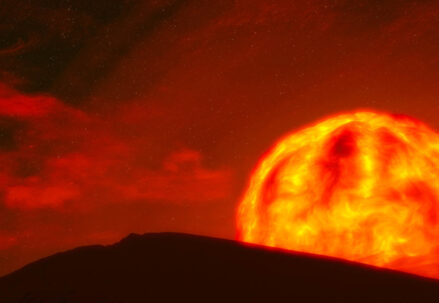An accomplished physicist and an editor for ‘The Secrets Of The Universe’, this individual hails from Punjab, India, boasting a Master’s in Physics. Currently, they are delving into doctoral research on the Radio Emissions of Exoplanets in Barcelona, Spain. Their passion for writing encompasses a vast range of topics, including planetary sciences, observational astrophysics, quantum mechanics, atomic physics, and the ongoing advancements in the space industry.
Understanding Coordinates: Earth and Beyond
Navigating through the expansive universe, much like finding a destination on Earth, requires an intricate understanding of coordinates. On our planet, this is achieved through the familiar latitude and longitude system, efficiently mapping every nook and cranny of the terrestrial landscape. However, when our gaze shifts skywards, towards the boundless depths of space, the complexity magnifies. Celestial objects, nestled in the vastness of the cosmos, demand a more sophisticated method of location – a challenge boldly met by celestial coordinate systems.
These systems are not mere academic constructs; they are the backbone of astronomical exploration and understanding. As we delve into the fifth chapter of the ‘Basics of Astrophysics’ series, a comprehensive exploration of these celestial coordinate systems unfolds. These systems are paramount in identifying and studying the positions of stars, planets, and other astronomical entities. They extend our geographical mapping capabilities beyond the confines of our planet, allowing us to chart a course through the very fabric of space.
Understanding celestial coordinates is akin to learning a new language – a language that speaks of the positions and movements of heavenly bodies. It’s a fundamental step for any aspiring astronomer or astrophysicist, crucial for making sense of the universe’s vastness. This exploration not only enriches our knowledge of the cosmos but also connects us more deeply with the mysteries of the night sky. As we progress through the series, these celestial coordinates will serve as our guide, leading us to a deeper appreciation of the cosmic dance that unfolds above us.
The Celestial Sphere: An Introduction
Picture an immense, imaginary sphere enveloping us, similar to a planetarium’s dome, where celestial bodies seem to reside. This is the celestial sphere concept. Two pivotal points on this sphere, the Zenith and Nadir, are determined by a line through the observer along Earth’s gravity. The celestial horizon is a great circle cutting through this sphere, while the celestial equator links the North and South Celestial points, mirroring Earth’s equator. The Meridian, another great circle, intersects these points and the Zenith-Nadir line. The ecliptic, marking the Sun’s yearly path, intersects the celestial equator at the equinoctial points, crucial in celestial mapping.
The Three Celestial Coordinate Systems
With a foundational grasp of the celestial sphere, we embark on an exploration of the three primary celestial coordinate systems, each offering a unique lens to view and understand the universe.
- Horizontal Coordinate System (Altitude and Azimuth)**: This system roots itself in the observer’s perspective. Here, the Zenith – the point directly overhead – and the horizon become crucial reference points. By measuring the angular distance of a star or celestial body from the horizon, known as its Altitude, and its direction relative to the north point, termed Azimuth, we can pinpoint its location in the sky as seen from a specific place on Earth. This system is dynamic, changing with the observer’s location and time, making it ideal for local astronomical observations;
- Equatorial Coordinate System (Right Ascension and Declination)**: Drawing parallels to Earth’s latitude and longitude, this system offers a universal framework for celestial positioning. Declination, akin to latitude, measures a star’s angular distance north or south of the celestial equator. Right Ascension, analogous to longitude, gauges the star’s eastward distance along the celestial equator from the First Point of Aries. This system remains constant over time, making it indispensable for cataloging and long-term tracking of celestial objects;
- Ecliptic Coordinate System (Celestial Latitude and Longitude)**: Centered on the Sun’s apparent path – the ecliptic – this system is crucial for studying solar system objects. Celestial Latitude measures the angular distance of a body from the ecliptic, while Celestial Longitude records its angular distance eastward from the First Point of Aries. This system aligns with the plane of the solar system, offering a natural framework for understanding the positions and movements of planets, asteroids, and comets.
Each of these celestial coordinate systems provides a unique method for mapping the heavens, tailored to different astronomical needs and perspectives. Together, they form a comprehensive toolkit, allowing astronomers to navigate, study, and appreciate the vastness and beauty of the cosmos.
Author’s Message
The celestial coordinate system stands as a fundamental pillar in the realm of astronomy and astrophysics, its complexity at first seeming daunting. Yet, with continued exploration and study, the veil of intricacy begins to lift, revealing a system both logical and elegant. The author’s primary goal is to unravel these sophisticated concepts, transforming them into comprehensible and accessible knowledge. This endeavor is not just about imparting information; it’s about building a strong, foundational understanding that is vital for anyone venturing deeper into the fields of astronomy and astrophysics.
This journey through celestial coordinates is more than a mere academic exercise; it is a gateway to the universe. It equips learners with the tools to not only locate celestial bodies but also to comprehend their motion and place within the cosmos. These coordinates form the language through which we can read the stories of stars, galaxies, and other celestial phenomena.
Engagement and curiosity are highly encouraged, as they are the catalysts for deeper understanding and discovery. The author welcomes questions and discussions, recognizing that learning is a collaborative and evolving process. As readers navigate through these concepts, they join a community of thinkers and explorers, all united in their quest to unlock the secrets of the universe. This journey, rich with learning and discovery, is an invitation to all who wish to delve into the fascinating world of astrophysics and beyond.
Conclusion: Navigating the Cosmos
In the vast expanse of space, celestial coordinate systems serve as the map and compass, guiding astronomers and astrophysicists through the cosmic ocean. The journey from understanding Earth’s geographic coordinates to grasping celestial coordinates marks a significant leap in human endeavor to comprehend the universe. These systems not only offer a method to locate celestial objects but also embody the intricate relationship between Earth and the cosmos.
The Horizontal, Equatorial, and Ecliptic Coordinate Systems are not just tools for navigation; they are symbols of human curiosity and our quest to find our place in the universe. Each system, with its unique parameters and perspectives, enriches our understanding of the sky and deepens our connection to the cosmos. The celestial sphere, an imaginary construct, brings the distant stars within our conceptual reach, allowing us to chart their positions and movements with precision and awe.
As we continue to explore the heavens, these celestial coordinates remind us of our humble beginnings and our boundless potential. They are a testament to our enduring quest for knowledge and a beacon for future explorations. In the pursuit of celestial mysteries, these coordinate systems are not just scientific tools; they are the legacy of our cosmic journey, a journey that each new generation of astronomers and astrophysicists will continue with passion and wonder.





